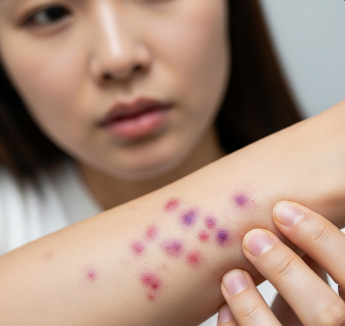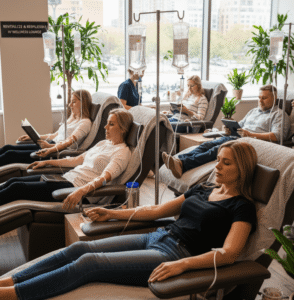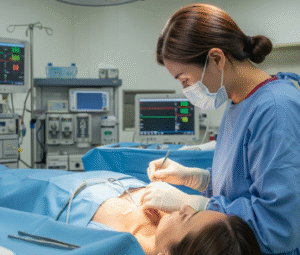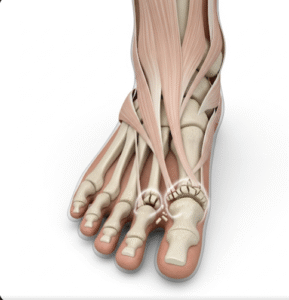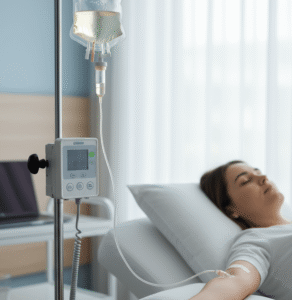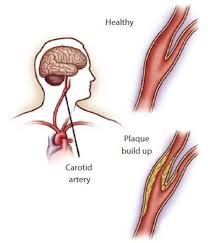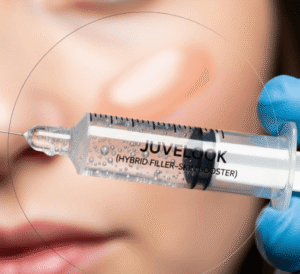Overview
Purpura refers to purple or reddish spots on the skin or mucous membranes that occur when small blood vessels (capillaries) leak blood under the skin. Unlike a rash, purpura does not blanch (fade) when pressed.
Purpura can range from small pinpoint dots (petechiae) to larger patches (ecchymoses). It is not a disease in itself but a sign of an underlying condition, often related to bleeding disorders, low platelet count, vascular inflammation, or clotting abnormalities.
In Korea, advanced hematology, dermatology, and internal medicine specialists provide comprehensive evaluation and treatment of purpura. With access to cutting-edge diagnostics such as blood tests, bone marrow biopsy, and autoimmune screening, patients can receive targeted treatment at world-class hospitals.
➤ Purple or red non-blanching spots on skin/mucous membranes
➤ Caused by blood leaking from capillaries under the skin
➤ May signal bleeding disorders, infections, or autoimmune diseases
Key Facts
➤ Purpura is not a disease, but a symptom of underlying conditions.
➤ Classified as non-thrombocytopenic (normal platelet count) or thrombocytopenic (low platelet count).
➤ Can indicate serious blood disorders, vasculitis, or infections.
➤ Requires medical evaluation if persistent, widespread, or associated with systemic illness.
What is Purpura?
Purpura is defined as extravasation of blood into the skin or mucous membranes, leading to visible discoloration.
- Petechiae: very small spots (<2 mm).
- Purpura: larger than petechiae (2–10 mm).
- Ecchymoses: large bruises (>10 mm).
These lesions do not fade with pressure because blood has already leaked outside the vessels.
What Symptoms Are Related To
Purpura is most often noticed as skin discoloration, but it may be associated with other symptoms depending on the underlying cause:
➤ Purple or red patches on skin, especially on legs or arms.
➤ Spots inside the mouth or on mucous membranes.
➤ Easy bruising.
➤ Nosebleeds or gum bleeding.
➤ Prolonged bleeding from cuts.
➤ Fatigue, weakness (with anemia).
➤ Joint pain or swelling (if due to vasculitis).
➤ Fever or systemic illness (if due to infection or autoimmune disease).
What Causes / Possible Causes
Purpura has multiple causes, broadly categorized as platelet-related, vascular-related, or clotting-related:
➤ Thrombocytopenic Purpura (Low Platelets)
➤ Immune thrombocytopenic purpura (ITP).
➤ Leukemia, aplastic anemia, or bone marrow disorders.
➤ Chemotherapy or radiation-induced marrow suppression.
➤ Drug-induced platelet destruction.
➤ Non-Thrombocytopenic Purpura (Normal Platelets)
➤ Vasculitis (inflammation of blood vessels, e.g., Henoch-Schönlein purpura).
➤ Infections (meningococcemia, septicemia, endocarditis).
➤ Scurvy (vitamin C deficiency).
➤ Aging skin or long-term corticosteroid use (capillary fragility).
➤ Clotting Disorders
➤ Hemophilia.
➤ Disseminated intravascular coagulation (DIC).
➤ Liver disease (impaired clotting factor production).
When Should I See My Doctor
Seek medical attention if you develop:
➤ Sudden, widespread purpura without known trauma.
➤ Purpura with fever, headache, or stiff neck (possible meningococcal infection – medical emergency).
➤ Purpura with severe fatigue, bone pain, or recurrent infections (possible leukemia).
➤ Purpura with nosebleeds, gum bleeding, or prolonged bleeding.
➤ Purpura in children following a viral infection (may indicate ITP or Henoch-Schönlein purpura).
Care and Treatment
Treatment for purpura depends on the underlying cause.
➤ General Measures
➤ Rest and avoidance of trauma.
➤ Discontinuation of medications that may cause purpura (blood thinners, steroids).
➤ Specific Treatments
➤ ITP (Immune Thrombocytopenic Purpura): Corticosteroids, IV immunoglobulin (IVIG), splenectomy in refractory cases.
➤ Vasculitis (Henoch-Schönlein Purpura): Supportive care, steroids for severe kidney involvement.
➤ Leukemia or Bone Marrow Disorders: Chemotherapy, bone marrow transplantation.
➤ Infections: Immediate antibiotic therapy (especially for meningococcal infection).
➤ Nutritional Deficiency (Scurvy): Vitamin C supplementation.
➤ Clotting Disorders: Factor replacement therapy, fresh frozen plasma.
Treatment Options in Korea
Korea offers world-class medical care for hematological and vascular conditions presenting with purpura. Patients benefit from:
➤ Top Hospitals in Korea for Purpura & Related Conditions
➤ Asan Medical Center (Seoul): Advanced hematology and oncology for leukemia and ITP.
➤ Samsung Medical Center: Expertise in autoimmune vasculitis and rare clotting disorders.
➤ Seoul National University Hospital (SNUH): Comprehensive care in pediatric hematology for childhood purpura.
➤ Severance Hospital (Yonsei University): Specialized in infectious causes of purpura and emergency care.
➤ Advanced Diagnostic Tools Available
➤ Complete blood count (CBC) with platelet count.
➤ Bone marrow biopsy for suspected leukemia or marrow failure.
➤ Autoimmune and vasculitis markers (ANA, ANCA).
➤ Clotting profile (PT, aPTT, INR).
➤ Modern Interventions
➤ Immunotherapy and biologics for refractory ITP.
➤ Stem cell transplantation for leukemia.
➤ Pediatric care units specializing in Henoch-Schönlein purpura.
➤ Emergency infectious disease management (meningococcal sepsis).

